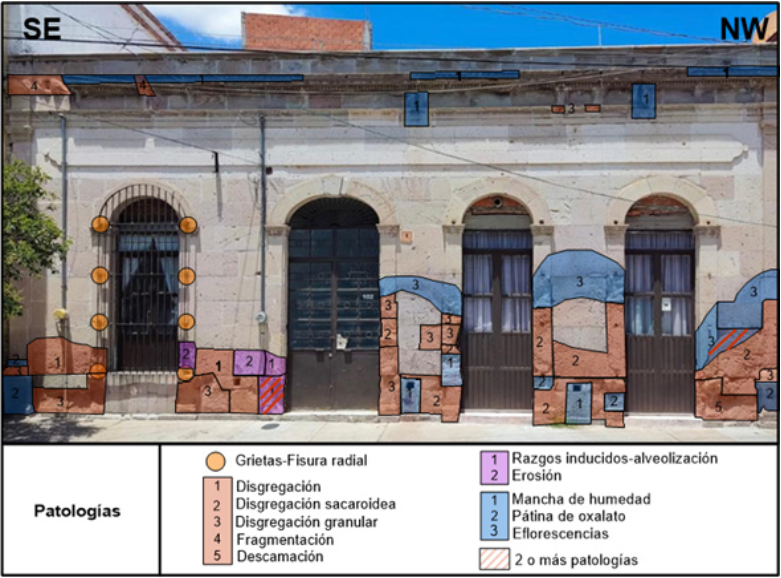Abstract
Ignimbrite is a volcanic rock widely used in historical buildings and monuments in Mexico due to its versatility, durability, availability, and aesthetic appeal. Ensuring restoration and preservation of buildings and monuments relies heavily on understanding the petrological properties of the rocks employed in their construction, alongside other physical traits such as porosity. This study outlines a methodology and findings regarding assessing decay in masonry of the historic building Casa Rosal 102a, in the La Purisima district of Aguascalientes, México. This evaluation relies on petrological characterization, represented as mapped data, focusing on volcanic rocks comprising the building’s facade. This research analysis drew comparisons between the petrological characterization mappings and those generated from rock pathologies. The latter were formulated using criteria outlined in the Illustrated Glossary of Degradation Phenomena and Processes (ICOMOS-ISCS), a resource crafted by the International Council on Monuments and Sites (ICOMOS) as an integral component of the UNESCO chair for world heritage preservation. The described methodology was developed during the COVID-19 pandemic as a field practice supervised by the instructors for first-semester students in the Civil Engineering Master's program at the Universidad Autónoma de Aguascalientes. It aimed to provide hands-on experience in the petrological characterization of volcanic rocks and evaluating historical buildings in Aguascalientes. Analysis revealed a diverse range of damages primarily concentrated in the lower areas, notably the northwest section of the facade. These damages predominantly stem from the rock's soldering characteristics, which, in these instances, oppose the expected porosity. The uneven capillary water ascent through the rock accumulates moisture primarily on the NW side of the facade.
References
Brown, R. J., y Andrews, G. D. (2015). Deposits of pyroclastic density currents. In the encyclopedia of volcanoes. Academic Press. pp. 631-648.
Cas, R. A. F., y Wright, J. V. (1987). Volcanic successions: Ancient and modern. Allen and Unin, London.
Delgado-Rodrigues, J. (1991). Causes, mechanisms and measurement of damage in stone monuments. Science, Technology and European Cultural Heritage.
Fisher, R. V. (1966). Rocks composed of volcanic fragments and their classification. Earth-Science Reviews, 1(4), 287-298
Fort, R., García del Cura, M., Varas, M. J., Bernabéu, A., Álvarez de Buergo, M., Benavente, D., y Pérez-Monserrat, E. M. (2008). La petrología: una disciplina básica para el avance en la investigación y conservación del Patrimonio.
García de Miguel, J. M. (2011). ICOMOS-ISCS: Illustrated glossary on stone deterioration patterns= Glosario ilustrado de formas de deterioro de la piedra. https://openarchive.icomos.org/id/eprint/2089/1/spanish_glossary.pdf
Grimmer, A. E. (1984). A Glossary of Historic Masonry Deterioration Problems and Preservation Treatments. Washington DC: National Parks Service.
López-Doncel, R., Cardona-Velázquez, N. y Wedekind, W. (2015). El rescate del patrimonio cultural pétreo de San Luis Potosí. Revista Universitarios Potosinos, 194, 6-12.
McDowell, F. W. y Clabaugh, S. E., 1979, Ignimbrites of the Sierra Madre Occidental and their relation to the tectonic history of western Mexico: Geological Society of America Special Paper, 180, 113- 124.
Orenday Tapia, E. E., Tapia Tovar, E., y Pacheco Martínez, J. (2019). Intervenciones no destructivas para el diagnóstico de la salud estructural de dos templos de Aguascalientes, en México. Intervención (México DF), 10(19), 85-98.
Ostrooumov, M., Monroy, V. H. G., Nieto, H. C., y Santacruz, R. L. (2003). Mineralogía y geoquímica de los procesos de degradación en monumentos históricos: primer acercamiento a un caso mexicano (Morelia, Michoacán). Revista Mexicana de Ciencias Geológicas, 20(3), 223-232.
Padilla-Ceniceros, R., Pacheco-Martínez, J., López-Doncel, R. A., y Orenday-Tapia, E. E. (2017). Rock deterioration in the masonry walls of the Cathedral Basilica of Aguascalientes, Mexico. Revista Mexicana de Ciencias Geológicas, 34(2), 138-149.
Quane, S. L., y Russell, J. K. (2005). Ranking welding intensity in pyroclastic deposits. Bulletin of Volcanology, 67, 129-143.
Ross, C. S., y Smith, R. L. (1961). Ash-flow tuffs: their origin, geologic relations, and identification (No. 366). United States Government Printing Office.
Rubalcava, G., y Sifuentes, R. R.(Coordinadores).(2014). Refugio Reyes Rivas, Arquitecto empírico, Instituto Cultural de Aguascalientes, 29 p.
Siegesmund, S., Weiss, T., y Vollbrecht, A. (2002). Natural stone, weathering phenomena, conservation strategies and case studies: introduction. Geological Society, London, Special Publications, 205(1), 1-7.
Siegesmund, S., Pötzl, C., López-Doncel, R., Gross, C. J., Dohrmann, R., y Ufer, K. (2022). Overview and quality assessment of volcanic tuffs in the Mexican building heritage. Environmental Earth Sciences, 81(17), 426.
Scholle, Ullmer, D. S., Scholle, P. A., Schieber, J., y Raine, R. J. (2014). A color guide to the petrography of sandstones, siltstones, shales and associated rocks (Vol. 109). Tulsa, OK, USA: American Association of Petroleum Geologists.
Smith, R. L. (1960). Zones and zonal variations in welded ash flows (No. 354-F, pp. 149-159). US Geological Survey. Sparks, R. S., Self, S., Walker, G. P. L. (1973). Products of ignimbrite eruptions. Geology 1:115-118
Solano, J. P. (2018). Estratigrafía y petrografía del Plio-Pleistoceno del noroeste de Costa Rica: Formación Bagaces y Lavas Pelón de la Bajura. (Unpublished licenciatura thesis). Universidad de Costa Rica, San José, Costa Rica.
Terry, R. D., y Chilingar, G. V. (1955). Summary of "Concerning some additional aids in studying sedimentary formations," by MS Shvetsov. Journal of Sedimentary Research, 25(3), 229-234.

This work is licensed under a Creative Commons Attribution-NonCommercial 4.0 International License.
Copyright (c) 2023 Universidad Nacional Autónoma de México

